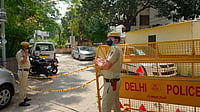The year 2023 is critical to the Narendra Modi-led Government of India and not just because this is the year that would set the tone for 2024 general elections in which the Prime Minister would seek re-election for the second time. This is also the year in which India would host the galaxy of world leaders as the Chair of G-20.
Key meetings of the Group of 20 —G-20— are already taking place across the country which has seen the participation of top diplomats and officials. These events will culminate in the G-20 Summit in New Delhi which would host the Presidents and Prime Ministers of the G-20 countries — the who’s who of the world such as US President Joe Biden, UK Prime Minister Rishi Sunak, and French President Emmanuel Macron.
The Modi government is portraying India’s G-20 presidency as a sign of its growing hard power. By organising meetings in several different cities, the Modi government is also flaunting India’s diversity and culture, the key to its soft power — even though the soft power overdrive coincides with attacks on Christians and Muslims and the erasure of the Islamic past from history textbooks.
As it happens in every institution before a key visit, India is undergoing a beautification drive at the moment. Slums are being removed near meeting venues so that the visiting dignitaries don’t see India’s poverty. They would be shown a rising India — despite the fact that 80 crores “poor” of India's 130 crore population had to be provided free ration during the Covid-19 pandemic.
Slums in the Pragati Maidan area of New Delhi where a key G-20 meeting would take place have already seen eviction. Here we trace similar evictions in the past and how the Indian Judiciary has dealt with such cases.
Trends of forced evictions in recent past
During 2017-21, a total of 1,91,070 houses were demolished and 9,48,493 people were evicted in India, according to a 2022 report by Housing and Land Rights Network India (HLRN).
While the trends of demolitions have evolved in the recent past, where demolitions have become central to the Bharatiya Janata Party’s (BJP) vision of collective punishment for alleged wrong-doers, the demolitions have traditionally been linked primarily to encroachment or beautification purposes.
Similar to the current rounds of evictions, over 2,00,000 persons were evicted from their dwellings in Delhi in the run-up to the 2010 Commonwealth Games, according to HLRN.
“Based on fieldwork and research, HLRN estimates that since 2004, at least 200,000 people in Delhi have been forcibly evicted as a result of the CWG. The city, however, witnessed many more demolitions and evictions in the run-up to the Commonwealth Games,” says a report titled Planned Dispossessions: Forced Evictions and the 2010 Commonwealth Games by HLRN.
The Delhi High Court in a judgement noted that the CWG-related evictions went beyond their stated numbers.
“It was pointed out by the MCD that the Gadia Lohar Basti consisted only of 15/16 jhuggis that were removed whereas altogether around 1000 jhuggis were removed in whole length of the road between the two stadiums,” said Delhi HC in a judgement in Sudama Singh & Others vs Government Of Delhi & Anr (2010).
What does the law say on eviction, and housing?
Shelter and housing have often been seen as an extension of the fundamental right to life enshrined in the Constitution. This has often been the basis for seeking legal relief when faced with evictions.
Article 21 of the Constitution says, “No person shall be deprived of his life or personal liberty except according to procedure established by law.”
However, it is what experts call a ‘conditional’ right, which means that this right comes into play when certain conditions of state action are there. This means this is not an inherent right.
“A claim under the right to shelter would stand conditional upon the existence of a particular policy/statute which must provide for the means to facilitate exercising the right. In this case, such policy/statute is the Relocation Policy. The right would be violated only when the state fails to fulfil its obligations under the policy/statute, as opposed to other rights where the state has only to not actively violate or block them by taking a violative measure,” note Talha Abdul Rahman and Husain Aanis Khan in The Wire.
In a 1985 judgement, the Supreme Court noted that people do encroachment when they are out of choice over the issue of shelter and even eviction should be methodical. Moreover, the SC went into the legal theory to highlight the defence against encroachment.
“The encroachments committed by these persons are involuntary acts in the sense that those acts are compelled by inevitable circumstances and are not guided by choice. Trespass is a tort. But, even the Law of Torts requires that though a trespasser may be evicted forcibly, the force used must be no greater than what is reasonable and appropriate to the occasion and, what is even more important, the trespasser should be asked and given a reasonable opportunity to depart before force is used to expel him....Besides, under the Law of Torts, necessity is a plausible defence, which enables a person to escape liability on the ground that the acts complained of are necessary to prevent greater damage, inter alia, to himself,” said the judgement.
Courts' balancing act on eviction issue
The jurisprudence around forced evictions has been built with a number of judgments that navigate state actions, illegal occupation of public land, and the question of welfare. The fundamental right to life is often cited as a means to seek relief whereas the state cites its duty to preserve order and free the land of encroachment.
A report by HLRN notes, “Though the Supreme Court of India and several state High Courts have, in numerous judgments, upheld the right to housing/shelter as an inalienable component of the fundamental right to life, in 2018, court orders and their interpretation by state authorities were responsible for 27 of the total incidents of forced eviction recorded by HLRN.”
In a 2018 petition, the Madurai bench of the Madras High Court ruled 198 settlements as encroachments and ordered their removal for the protection and restoration of a water body. Earlier in 2014, the court had ordered the eviction of 315 houses in Chennai. The HLRN noted that families had been living there for over 50 years. Similarly, 211 houses were demolished at the order of the court along the Vasishta River.
In a judgement on a 2009 petition, the Madras High Court prohibited the regularisation of settlements near water bodies that ruled out any rehabilitation, noted HLRN.
“The Madras High Court, in W.P. 1294/2009, had categorically prohibited the regularization of settlements situated near water bodies such as Korattur Lake, leaving no scope for in situ rehabilitation of the residents, forcing them to relocate to sites situated on city outskirts,” said the report.
In a 2018 judgement, the Madurai High Court held that a person residing on land notified as a water body in revenue records shall not be included in the voter list.
In a judgement on a 2013 petition, the Uttarakhand High Court noted towns were becoming slums and ordered the demolition of 50 houses.
“In Prem Nagar, Dehradun, an order of the Uttarakhand High Court in W.P. (PIL) 47/2013 led to the demolition of 50 houses. In the order dated 18 June 2018, the Court stated that ‘Towns have been reduced to the status of slum areas,’ and consequently, directed the authorities to remove all unauthorised encroachments on public streets ‘by using its might,’ including the imposition of Section 144 of the Criminal Procedure Code to aid the demolition process and prevent any protest,” notes the HLRN report about the court order.
Acting on a 2009 order of the Bombay High Court, the Brihanmumbai Municipal Corporation (BMC) in 2017 ordered the demolition of 5,225 slum houses for a cycle track. Thousands of houses were demolished in the drive. However, the estimate of houses to be demolished reached 20,000 in 2018, around 16,000 of which had already been demolished by that time, according to a report in DNA.
The DNA report said that the HC order was to protect a pipeline around which thousands of slum dwellings had come up. The area up to 10 metres around the pipeline was to be cleared to keep it safe, on which a cycle track was to be built, said the report.
However, there also have been judgements and court orders in which the Judiciary has taken the side of those being evicted. In Ajay Maken & Ors. vs Union Of India & Ors, the Delhi High Court-monitored the aftermath of eviction in 2015 in Delhi’s Shakur Basti area and affirmed the right to housing.
“The right to housing is a bundle of rights not limited to a bare shelter over one's head. It includes the right to livelihood, right to health, right to education and right to food, including right to clean drinking water, sewerage and transport facilities,” said the court in the 2019 judgement in the case, which also said that evictions cannot happen without due process.
However, the most landmark judgement over evictions is Olga Tellis v. Bombay Municipal Corporation (1985). In the judgement, the SC acknowledged the policy of rehabilitation of those evicted. The apex court also noted that while relief is being allotted to long-time dwellers, the act of building houses on public property remains illegal — while also noting that such encroachments happen out of helplessness.
The SC said, “No one has the right to make use of a public property for a private purpose without the requisite authorisation and, therefore, it is erroneous to contend that the pavement dwellers have the right to encroach upon pavements by constructing dwellings thereon.”
The apex court further said, “There is no doubt that the petitioners are using pavements and other public properties for an unauthorised purpose. But, their intention or object in doing so is not to 'commit an offence or intimidate insult or annoy any person', which is the gist of the offence of "Criminal trespass" under section 441 of the Penal Code. They manage to find a habitat in places which are mostly filthy or marshy, out of sheer helplessness.”


























